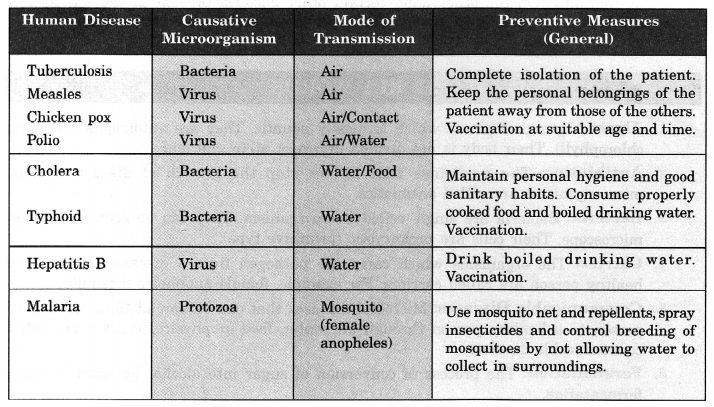Microbes are classified into four groups as:
- Protozoa
- Bacteria
- Fungi
- Algae
Microorganisms
- Microorganisms are microscopic organisms that cannot be seen with the naked eye.
- These organisms are usually unicellular in nature.
Friendly Microorganisms
The bacterium, Lactobacillus converts milk into curd.
Bacteria are also involved in the making of cheese, pickles and many other food items.
Acetobacter aceti bacteria is used for the production of acetic acid from alcohol.
Yeast is used for commercial production of alcohol and wine by growing them on natural sugars present in grains like barley, wheat, rice and crushed fruit juices etc.
Antibiotics are manufactured by growing specific microorganisms and are used to cure a variety of diseases.
Some microorganisms reside in the root nodules of leguminous plants. They can fix atmospheric nitrogen from the air into the soil and increase soil fertility.
Specialized bacteria convert nitrates and nitrites present in the soil into nitrogen gas which is released in the atmosphere.
Harmful Microorganisms
The bacterium, Lactobacillus converts milk into curd.
Disease-causing microorganisms are called pathogens.
Common ailments like cold, influenza (flu) and most coughs are caused by viruses. Serious diseases like polio and chicken pox are also caused by viruses.
Diseases like dysentery and malaria are caused by protozoans.
Typhoid and tuberculosis (TB) are caused due to bacteria.
Some common diseases, their modes of transmission and preventive measures are given below.
Some Common Human Diseases Caused by Microorganisms

Foot and mouth disease of cattle is caused by a virus. Anthrax, a bacterial disease is very fatal for human and cattle.
Some of the Common Plant Diseases
| Plant Diseases | Microorganism | Mode of Transmission |
| Citrus Canker | Bacteria | Air |
| Rust of wheat | Fungi | Insects and seeds |
| Yellow vein mosaic of bhindi (okra) | Virus | Insect |
Food Poisoning: Microorganisms that grow on our food sometimes produce toxic substances. These make the food poisonous and result in serious illness and even death.
Food Preservation
Salts, sugar, edible oils and vinegar are the common chemicals generally used to check the growth of microorganisms. Therefore, they are called preservatives.
Heat and cold treatments also inhibit the growth of microbes.
Pasteurization of Milk: The milk is heated to 70°C for 15 seconds and then suddenly chilled and stored. Such milk is referred to as. pasteurized milk.
Symbiotic bacterium: Rhizobium helps in the fixation of nitrogen with the root of the leguminous plant. The action of lighting also helps into the fixation of nitrogen.
Nitrogen cycle: Nitrogen from the atmosphere is converted into nitrogen compounds by some bacteria like rhizobium and blue-green algae present in the soil and also by lightning. On the other hand, certain other bacteria present in the soil convert nitrogen compounds into nitrogen gas that is released to the atmosphere.
Algae: A group of plants which is mostly aquatic. They are autotrophs (i.e., have chlorophyll). Their body is not divided into root, stem and leaf.
Antibiotics: The medicines that kill or stop the growth of disease-causing microorganisms are called antibiotics.
Bacteria: Bacteria are single-celled microorganism. They can be seen only under a microscope. Their cells are prokaryotic (primitive type).
Carrier: The organisms which carry the pathogen from a diseased person to a healthy person are called carriers. For example, female Anopheles mosquito.
Communicable Diseases: Microbial diseases that can be spread from an infected person to a healthy person through the air, water, food or physical contact are called communicable diseases.
Fermentation: The process of conversion of sugar into alcohol by yeast is called fermentation.
Fungi: Fungi are non-green plants. They cannot synthesize their own food. They may be unicellular or multicellular.
Lactobacillus: Lactobacillus is the bacteria responsible for the formation of curd from milk.
Microorganisms: These are organisms that are too small and are not visible to the naked eye. These include a virus, bacteria, fungi, protozoa and some algae.
Nitrogen Cycle: A process (cycle) by which the amount of nitrogen remains constant in the atmosphere is known as the nitrogen cycle.
Nitrogen Fixation: The process of conversion of atmospheric nitrogen into its usable forms is called nitrogen fixation.
Pasteurisation: The process in which milk is heated to about 70°C for 15 to 30 seconds and then suddenly cooled.
Pathogen: Disease-causing microorganisms are called pathogens.
Preservation: Prevention of spoiling of food from the action of microorganisms is called food preservation.
Protozoa: Protozoa are unicellular animals.
Rhizobium: Rhizobium is a bacterium which lives in the root nodules of leguminous plants. This helps in the fixation of nitrogen.
Vaccine: The substance which is injected to trigger the body to develop its own defence (by producing antibodies) is called vaccine.
Virus: Viruses are living only inside other living cells. They are considered as connecting link between living and non-living.
Yeast: Yeast is a unicellular fungus.
ncert textbook solutions


